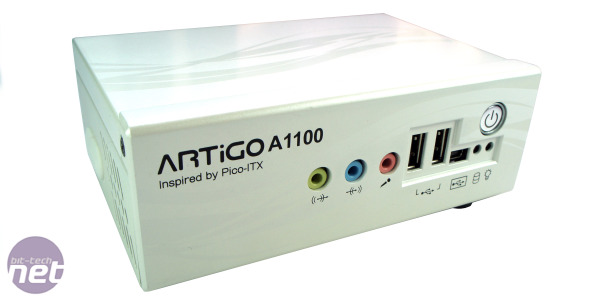Performance Analysis
Your estimations of what this pretty little box can do should equate to thinking of the Artigo A1100 as essentially a netbook with no screen or keyboard. VIA CPUs have never been speed demons in the past, but it's not until using one again that we're reminded why they tend to be quite so frustrating.During testing we were forced to work in an artificially linear manner, otherwise the system lags and has to catch up, even with Aero disabled. Our multi-tasking test proved an extreme example of this, even though it's merely doing just video playback and a file compression, which is something we take for granted in any modern system. Even dragging and opening windows in Windows 7 was laggy, so a more lightweight OS is almost necessary for use with the Artigo. At least this will shave £70 off the setup price.
However, as far as netbook hardware goes, at least the single-core, 1.2GHz VIA U2500 performed at the same level as Intel's 1.6GHz, dual-core Atom D330 in image editing. The single-core, 1/6GHz Atom N270 was also over 2 minutes slower than the VIA chip - if you've not realised already, Intel's Atom is seriously underpowered for a modern, general-purpose PC.
For very heavily CPU- and memory-intensive calculations the U2500 loses out to Intel's Hyper-Threading, and of course, the whole extra core of the D330 allowed it to be more responsive and to perform better when video encoding. That's to be expected, and we appreciate that VIA processor isn't designed with heavy use in mind, but it does show that Intel's decision to sacrifice out-of-order execution in favour of Hyper-Threading (which uses fewer transistors) does have some merit.
We expect that faster Nanos might be able to play the full 1080p WMV9HD when paired with the VX855 chipset, but the U2500 of the Artigo wasn't up to the task. SD DivX video played fine though, but that's really nothing to shout about.
Apart from the numbers and graphs, there's a bigger downside to the Artigo: heat. We found that it got far too hot for our liking - on one occasion the system locked up while running our benchmarks. We then tried running the system with the lid off to see if that helped, but it didn't - the heatsinks were so hot that we couldn't touch them. We worry about whether a hard disk in the case would overheat, as they can only handle temperatures of 60oC or so before their motor lubrication spoils.
We spoke to VIA about the issue and it confirmed that the A1100 does 'run a little hot under the hood', but that it has also 'passed rigorous testing and maintains stability under full load indefinitely'. VIA explained the lid needed to remain on during operation to aid airflow through the device, and insisted that the temperatures generated will not harm a hard disk installed in the Artigo.
Conclusion
The Artigo A1100 is a true PC enthusiast and modders product for low-power projects that require ultra-small PCs. It could be a fair choice for projects such as Car PCs (providing you only want one thing from it at once: music or GPS) or making your own all-in-one touchscreen control panel. Having everything in a single box without having to faff around worrying which case or PSU to buy is certainly an advantage.The Pico-ITX box achieves one thing: getting a full PC you could fit in a shoe, a small cubby hole, or even a manbag, if that's your thing. Think of any quirky little place you'd not normally find a PC, and Artigo will fit.
VIA is due for a dual-core CPU which will use a die shrink from 65nm manufacturing process of the Nano U2500 used in the A1100. The new 40nm manufacturing process should increase frequency and performance while lowering heat and potentially price; there's a quad-core version due next year too. Both upgrades will considerably boost the usability of VIA's CPUs and their competitiveness against Intel's Atom (that isn't due to change until late 2011). AMD's Bobcat Fusion APU might spoil VIA's party though, but we'll have to wait until early next year to see what the new processor can deliver.
The serious downside to the Artigo is its heat build-up, which means that it'll need modding before you install it in an unventilated nook or cranny. The Artigo A1100 needs a bigger, better fan to keep it cool. Given that it's using a CPU specifically designed for low power use, we didn't expect such a cooker.
The heat buildup in the box is a bit disappointing in what is otherwise a cheap little project box for odd and interesting low-power, super-small mods. Outside of that niche, there's not a whole lot going for the VIA Artigo A1100.
- Performance
- x
- x
- x
- x
- -
- -
- -
- -
- -
- -
- 4/10
- Features
- x
- x
- x
- x
- x
- x
- x
- -
- -
- -
- 7/10
- Value
- x
- x
- x
- x
- x
- x
- x
- x
- -
- -
- 8/10
- Overall
- x
- x
- x
- x
- x
- -
- -
- -
- -
- -
- 5/10

MSI MPG Velox 100R Chassis Review
October 14 2021 | 15:04










Want to comment? Please log in.